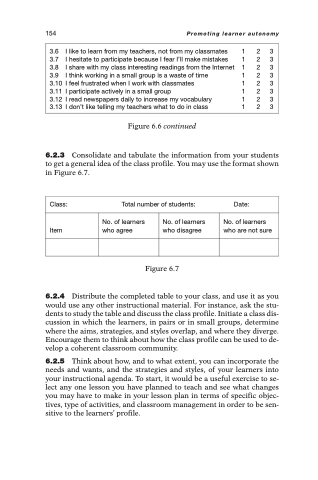Page 166 - Beyond Methods
P. 166
154 Promoting learner autonomy
3.6 I like to learn from my teachers, not from my classmates
3.7 I hesitate to participate because I fear I’ll make mistakes
3.8 I share with my class interesting readings from the Internet
3.9 I think working in a small group is a waste of time
3.10 I feel frustrated when I work with classmates
3.11 I participate actively in a small group
3.12 I read newspapers daily to increase my vocabulary
3.13 I don’t like telling my teachers what to do in class
1 2 3 1 2 3 1 2 3 1 2 3 1 2 3 1 2 3 1 2 3 1 2 3
Figure 6.6 continued
6.2.3 Consolidate and tabulate the information from your students to get a general idea of the class profile. You may use the format shown in Figure 6.7.
Class: Total number of students: Date:
Item
No. of learners who agree
No. of learners who disagree
No. of learners who are not sure
Figure 6.7
6.2.4 Distribute the completed table to your class, and use it as you would use any other instructional material. For instance, ask the stu- dents to study the table and discuss the class profile. Initiate a class dis- cussion in which the learners, in pairs or in small groups, determine where the aims, strategies, and styles overlap, and where they diverge. Encourage them to think about how the class profile can be used to de- velop a coherent classroom community.
6.2.5 Think about how, and to what extent, you can incorporate the needs and wants, and the strategies and styles, of your learners into your instructional agenda. To start, it would be a useful exercise to se- lect any one lesson you have planned to teach and see what changes you may have to make in your lesson plan in terms of specific objec- tives, type of activities, and classroom management in order to be sen- sitive to the learners’ profile.


